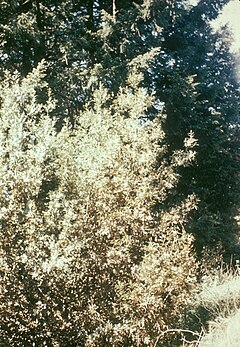Glomerella cingulata
Glomerella cingulata
Glomerella cingulata sur Umbellularia californica (Bitter rot).
Glomerella cingulat est une espèce de champignons parasites qui cause des maladies sur différents fruits et légumes sous le nom d'anthracnose avec une aire de répartition mondiale de la maladie[1],[2]. Des plantes cultivées comme le Millepertuis perforé ou Herbe de la saint-Jean (Hypericum perforatum) sont touchées[3]. Il cause aussi la maladie des feuilles d'Hevea brasiliensis[4].
Glomerella cingulata est le stade sexué (téléomorphe) alors que le stade asexué (anamorphe) est désigné par Colletotrichum gloeosporioides.
Taxonomie
[modifier | modifier le code]Synonyme
[modifier | modifier le code]Réaction végétale de défense
[modifier | modifier le code]La daniélone est un phénol naturel, une phytoalexine produite par la papaye Carica papaya pour combattre Colletotrichum gloeosporioides[5].
Notes et références
[modifier | modifier le code]- (en) Cet article est partiellement ou en totalité issu de l’article de Wikipédia en anglais intitulé « Glomerella cingulata » (voir la liste des auteurs).
- Nutritional Studies of Colletotrichum gloeosporioides (Penz.) Penz. and Sacc. The Incitant of Mango Anthracnose. C.G. Sangeetha and R.D. Rawal, World Journal of Agricultural Sciences, 2008, 4(6), pages 717-720 'abstract)
- New Safe Methods for Controlling Anthracnose Disease of Mango (Mangifera indica L.) Fruits Caused by Colletotrichum gloeosporioides (Penz.). Abd-AllA M.A. and Wafaa M. Haggag, Journal of American Science, 2010, 8(8), pages 361-367 (abstract)
- Impact of some fungicides on mycelium growth of Colletotrichum gloeosporioides (Penz.) Penz. & Sacc. Grażyna Filoda, Pesticides, 2008, (3-4), pages 109-116 (abstract)
- Inhibition of Colletotrichum gloeosporioides (Penz) Sac. causal organism of rubber (Hevea brasiliensis Muell. Arg.) leaf spot using plant extracts. N. O. Ogbebor, A. T. Adekunle and D. A. Enobakhare, African Journal of Biotechnology, 5 February 2007, Volume 6 (3), pages 213-218, (abstract)
- Danielone, a phytoalexin from papaya fruit. Echeverri F., Torres F., Quinones W., Cardona G., Archbold R., Roldan J., Brito I., Luis J.G., and LahlouU E.-H., Phytochemistry, 1997, vol. 44, no2, pp. 255-256, Modèle:INIST
Voir aussi
[modifier | modifier le code]Articles connexes
[modifier | modifier le code]Bibliographie
[modifier | modifier le code]Liens externes
[modifier | modifier le code]- (en) Référence BioLib : Glomerella cingulata (Stoneman) Spauld. & H. Schrenk
- (en) Référence Catalogue of Life : Colletotrichum gloeosporioides (Penz.) Penz. & Sacc. - synonyme
